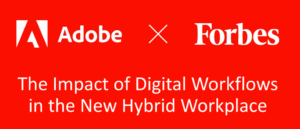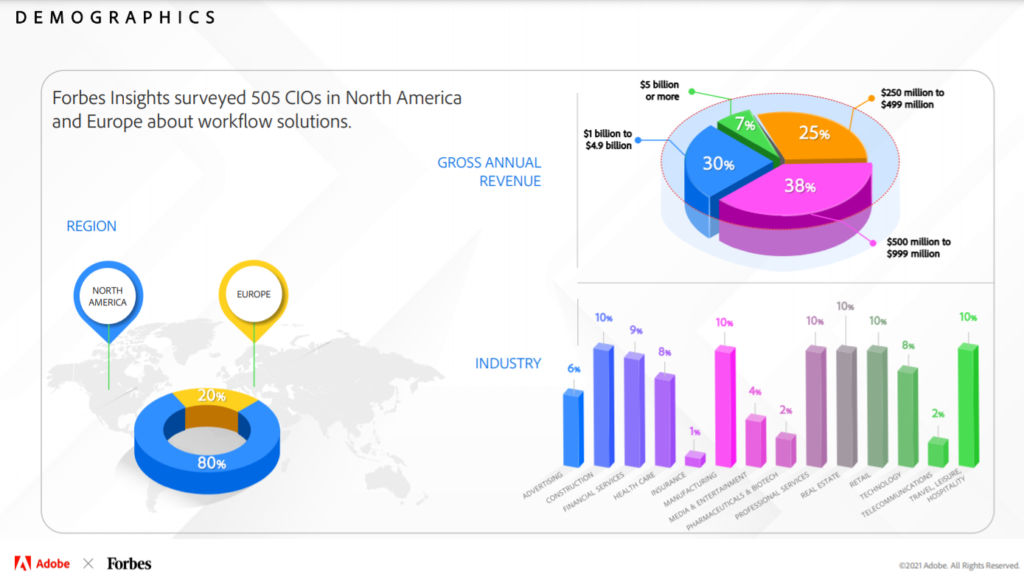M+E Connections

How Digital Workflows Help Companies Thrive in a Hybrid Work World
Story Highlights
Digital workflows can significantly help organisations thrive in the hybrid work world we are in today as a result of the COVID-19 pandemic, according to Simon Longbottom, VP of product marketing, Digital Media for Business at Adobe.
Digital workflows also help organisations deliver superior customer and employee experiences, and can help drive growth and competitive advantage.
“A lot of the digital workflow is about trying to take the friction out of the system” so employees can be more productive and focus on “high-value tasks,” Longbottom said June 16 during the webinar “The Impact of Digital Workflows in the New Hybrid Workplace.”
Adobe, for example, helped Pfizer improve its document approval process through the use of Microsoft Teams, taking manual steps out of the process to improve efficiency by 60%, he said.
The Future of Work
The future of work is likely going to be hybrid – “just how hybrid will vary by industry and company culture” and is “prone to adjustment in the months ahead,” according to webinar moderator Rich Karlgaard, a futurist and editor-at-large at Forbes.
As part of new CIO research done in conjunction with Adobe, Forbes Insights surveyed 505 CIOs across various industries in North America (80% of those surveyed) and Europe (20%) about workflow solutions, what their organisations were doing to adapt to the COVID-19 economy, and what their priorities are now, he said.
Company leaders are working “much more collaboratively” than ever before, according to the findings. Companies are also at different points in their COVID workplace journeys, Karlgaard said.
Eighty-six percent of respondents said that workflow solutions will be very important in managing a distributed, hybrid work structure going forward, he noted.
Meanwhile, more than half (52%) of the CIOs said workflow solutions are critical to success in managing a hybrid structure, compared to less than a third of other CIOs.
“Workflow and collaboration [are] incredibly important – and not just for us, for our customers as well,” according to Longbottom.
 Adobe is going to be “moving from more or less 100 percent remote to a hybrid work environment in the U.S. from the end of July and, in other locations, as it’s safe to do so,” he told viewers. “Everyone is going to be able to work from home two to three days a week. Employees can also apply to work remotely if they wish to. And so our approach is going to be flexible and digital-first. And we expect hybrid work to be the new normal for Adobe.”
Adobe is going to be “moving from more or less 100 percent remote to a hybrid work environment in the U.S. from the end of July and, in other locations, as it’s safe to do so,” he told viewers. “Everyone is going to be able to work from home two to three days a week. Employees can also apply to work remotely if they wish to. And so our approach is going to be flexible and digital-first. And we expect hybrid work to be the new normal for Adobe.”
The Adobe/Forbes survey results showed that many companies will be experimenting with a hybrid approach also, he noted.
“It’s incredibly important to look at it both from a customer and the employee experience point of view,” he said.
Using collaborative tools “can help you actually improve a customer experience – and it’s good for the customer and it’s good for” the company also, he pointed out.
“There’s a great opportunity to look at this as sort of a look-forward moment and the hybrid working could end up being better than what we were doing before,” he explained, adding: “There’s certainly been examples where people are much more productive because they’re saving long commutes every day [from when they] were going into the office that they can now use for both work and non-work activities that are helping them be happier and more productive. And I think we’ve shown that, through a full remote work model, we can be surprisingly productive.”
It is also easier for many employees to think when they work from home where it is quiet, he noted.
But it is important for companies to realise that everybody is different and so companies are working to come up with work models that work for all employees, he said.
Adobe takes a “data-driven approach” to helping its customers, he also told viewers. Getting rapid feedback about what is working and not working, and then iteration are important parts of what Adobe does, he said.
IDC’s Take
The number of employees working in a hybrid work model is “in flux” now and varies depending on industry, according to Amy Loomis, research director, Future of Work at IDC.
About 33% of workers globally overall will return to the office, the most recent IDC data show, she said.
“It’s not just where you’re working but why you’re working where you’re working that seems to be the guiding factor,” she noted.
 Digital investments are being made in the new hybrid work infrastructure and there has been an increased shift to reliance on cloud-managed and based connectivity, devices and services, she said IDC research showed.
Digital investments are being made in the new hybrid work infrastructure and there has been an increased shift to reliance on cloud-managed and based connectivity, devices and services, she said IDC research showed.
IDC data also indicated that the automation of repetitive tasks and workflows is becoming more ubiquitous.
“If you thought it was hard to migrate to remote models, you’ll see that it’s going to be equally if not more challenging to navigate these kinds of disruptions with hybrid,” she warned.
But IDC expects the investments that companies have made in hybrid work so far “are going to endure,” she said.
Workflow automation and processes help retain employees because they are “alleviating them from having to do some of the more redundant and repetitive tasks” at their jobs, as well as because it provides more options to employees and companies, she explained. For one thing, there is now a “broader talent pool that you can now pull from” as a company when looking for the right job candidate, she noted.
It is important for organisations to make sure they are prepared for a flexible, hybrid work scenario if they are not already.
After all, “COVID won’t be the last disaster that causes the need for this kind of adaptability,” Karlgaard predicted.









